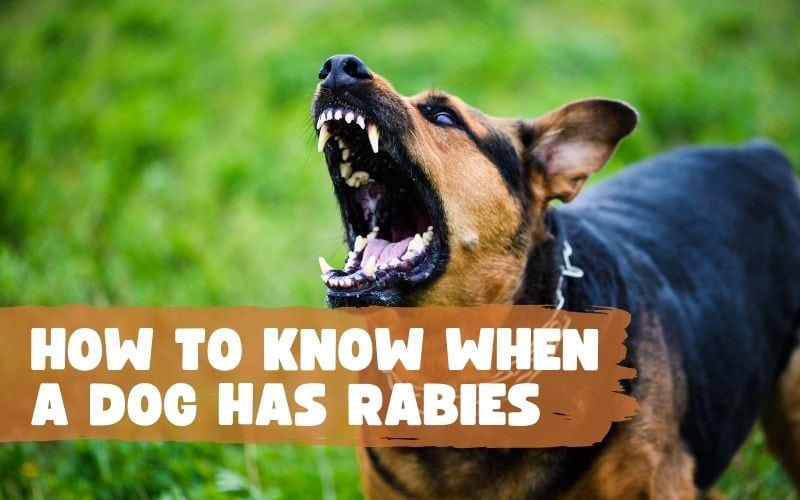Rabies is predominantly a contagious disease of the brain and spinal cord in both humans and dogs. The disease is carried through physical contact with other dogs. So, if you suspect your dog has come into contact with a mad dog, you should consider treating him or giving him rabies shots.
How to tell if a dog has rabies?
As the virus is primarily transferred through bites, if your dog develops unexplainable sores on his body, it’s a good idea to take him to the veterinarian. The main thing to do in such circumstances is to see if it’s infected with a rabid dog.
1. Early signs of rabies in dogs
This period can last anywhere between two and 10 days. Your dog will appear sick with typical symptoms throughout this period. Look for bite marks or recent combat signs on your dog if you observe these symptoms (scratches, scrabs, or wrinkled skin with dry saliva). Take your dog to the vet right away if you notice a bite mark or any form of a wound.
2. Symptoms of rabies in dogs
Knowing what to look for is the best way to reduce the chance of having rabies complications and infections. By observing some of the disease’s symptoms, you can determine when the dog is first infected, giving you plenty of time to seek medical attention before the problem worsens.
3. Aggression
The majority of dogs exhibit some level of aggression. If it gets worse quickly, it could be a sign of rabies, and you should see a veterinarian right away.
The rabid dog becomes aggressive, agitated, and exhibits signs of starvation, including chewing and devouring stones, soil, and garbage. As the disease progresses, the dog will become delirious and deranged and may be unable to eat or drink. Hydrophobia (fear of water) in dogs is not a rabies symptom. This is a symptom of rabies in humans. The condition of the dog worsens and death will come eventually.
4. Fever and drowsiness
You can detect whether your dog has a temperature by feeling his body but using a pet thermometer to check the readings will be more accurate. Although this is a non-specific sign of the disease, it is always a good idea to take the dog to the veterinarian for testing to ensure that it is not rabies.
5. Biting and restlessness
Always consult your veterinarian if you find your dog is acting more irritated than usual. This is especially true if he is acting inappropriately for no apparent reason. When dogs bite or snarl at people, it could be an indication that they are in the early stages of the disease.
6. Excessive salivation
Your dog may act strangely and produce foam around the mouth. This is the kind of rabies that most people are familiar with, although it is less prevalent in dogs, except in the form of paralysis.
It’s essential to consult a veterinarian right away if you notice excessive salivation. This is a common indicator that something is wrong. The majority of people describe it as mouth foam. This is because the dog’s jaw or throat is paralyzed, making swallowing difficult. They tremble as a result of this.
7. Scared of the objects
Another approach to recognizing if a dog has the condition is to look for sensitivity and nervousness in response to certain stimuli. Sound, light, and touch phobias are common in dogs with this condition, with light sensitivity being the most common.
In bright light, the dog may get agitated and bark. Or it may leave a brilliantly illuminated room. Making loud noises or using a strong spotlight can be used to evaluate sound, light, and other sensitivities.
8. Advanced signs and symptoms
Foaming at the mouth is one of the most prevalent rabies symptoms in dogs. Some dogs may not “foam,” but they may demonstrate excessive saliva instead. This is a sign that the virus has spread throughout the area.
Seizures and paralysis are common in the later stages of rabies. Dogs at this stage are unable to regulate their muscles, particularly those in their head and throat, making swallowing difficult. At this stage, they can’t breathe, which means death.
Conclusion
If your dog is exhibiting the symptoms listed above, it is likely that rabies (if at all the dog has rabies) is in its early stages. To reduce the chance of death from the disease, all you have to do is to take the dog to a qualified veterinarian.
Increased sensitivity to sound, light, and touch, difficulty to close the mouth, extreme lethargy, and heavy breathing are all symptoms of the acute stage of rabies in dogs. Don’t take any chances by allowing your dog to get infected by rabies.
Once the signs and symptoms of rabies set in and the dog exhibits rabid dog behavior, there is no treatment. If rabies is detected, the dog must be quarantined and kept from escaping or infecting others.
You can avoid all this by giving the dog rabies vaccine. Rabies vaccination can protect the dog from getting infected, even if it comes in contact with a rabid dog.
